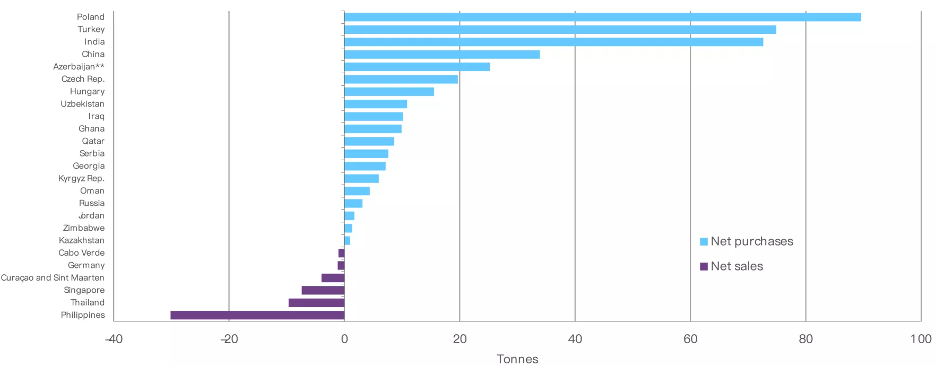Central banks around the world scooped up an additional 53 tons of gold in November 2024, underscoring the momentum of governmental demand. This marks the 15th straight year of net purchases by national-level investors which cements gold as a staple of modern economies. The World Gold Council’s (WGC) report reveals the growing role emerging markets play in the annual consumption of the yellow metal.
The November Leaderboard
The National Bank of Poland pulled ahead in November with the shiniest purchase of 21 tons, accounting for nearly half of November consumption. This puts the Eastern European government at the top of the annual leaderboard as it’s hauled in 90 tons in 2024, not including December. Now, gold comprises nearly 18% of the country’s reserves, on pace to hit its 20% goal.
Uzbekistan hiked its reserves by 9 tons, and India claimed 8 tons. Now, India is the second-largest yearly consumer behind Poland. Demonstrating strong Asian demand, the National Bank of Kazakhstan bought 5 tons, officially becoming a net purchaser. The central banks of Jordan, Turkey, the Czech Republic, and Ghana brought up the bottom of the list with 4, 3, 2, and 1-ton purchases, respectively.
China Resumes Gold Purchases
One of the most impactful developments in November was China’s resumption of gold purchases. After upping its reserves by 10% in 2023 and starting strong in 2024, the People’s Bank of China (PBoC) took a six-month breather in the middle of the year. This dry spell was broken decisively in November as China acquired 5 tons.
That pickup brings the country’s year-to-date total to 34 tons. With a reported 2,264 tons, the PBoC boasts the world’s sixth-largest gold reserves. China’s temporary inactivity in the gold market is seen as an exception rather than a rule as the country makes a concerted effort to diversify its reserves, even going as far as to implement gold-buying quotas. The recent discovery of the world’s largest gold deposits within China’s borders could dramatically speed up its economic objectives.
Emerging Markets Stay Ahead
A clear sign from November’s numbers is that emerging markets remain in charge of gold demand. These burgeoning nations have been consuming a disproportionate amount of the yellow metal compared to their size for the past few years. This recent development has been fueled by the de-dollarization movement as countries seek to shed their dependence on the dollar due to macroeconomic and weaponization concerns.
Gold has arisen as the go-to replacement for the world reserve currency due to tangibility, durability, and inherent value. Unlike the dollar, gold doesn’t pose an economic or national security risk to these countries. The rapidly growing debt of the US government and global relations only hastens the demand for gold among these nations.
Net Purchases Maintain
 Following years of net selling at the turn of the 21st century, central banks did a complete 180 with their strategies. 2024 officially marks the 15th consecutive year of net gold purchases, firmly establishing gold’s newfound value among modern economies.
Following years of net selling at the turn of the 21st century, central banks did a complete 180 with their strategies. 2024 officially marks the 15th consecutive year of net gold purchases, firmly establishing gold’s newfound value among modern economies.
According to the WGC, recent central bank gold demand has been “driven by the need for a stable and secure asset amid global economic uncertainties.” This sustained, record-setting demand has been the main driver behind the metal’s ongoing rally with gold price predictions for 2025 looking especially bullish.


